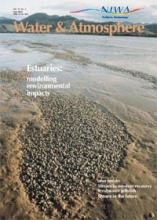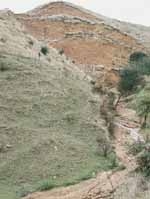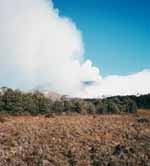PDF of this article (1 MB)

Kevin Collier Steph Parkyn John Quinn Mike Scarsbrook
For invertebrates intent on recolonising a stream after a disturbance or during stream restoration, simply getting to the stream site is only half the battle.
How far may a mayfly fly? Answers to this sort of question are important for understanding how long it takes a stream to recover from major disturbances, and for predicting whether sensitive stream insects will recolonise restored areas of stream. Much of the stream-life we are trying to restore is found in headwater remnants of undisturbed vegetation, which act as important “source areas” of animals moving to other sites. In order to predict the timescale of recovery, we must first determine how close restoration sites need to be to these remnants for recolonisation to occur.
We have been investigating stream invertebrate recolonisation using a combination of approaches including natural experiments, life-history studies and genetic analyses (see Water & Atmosphere 8(3): 17–18). The natural experiments have involved measuring stream invertebrate recolonisation patterns following three contrasting types of disturbance: a landslip, a large flood and a volcanic eruption.
The Whatawhata landslip

The 1995 landslip at Whatawhata. (Photo taken in February 1996)

Recolonisation patterns of selected invertebrate groups before and after a large slip into a pasture stream at Whatawhata.



Recolonisation patterns of selected invertebrate groups before and after the Whatawhata storm (at 0 months). There was a second storm at about 14 months indicated by the arrow.

Recolonisation patterns of four stream invertebrate groups in Mangaturuturu River for 24 months following the 1995 eruption of Mt Ruapehu.

Mt Ruapehu erupting in 1996.
In July 1995, a large landslip at the Whatawhata research station, west of Hamilton, displaced 0.41 ha of hillside. Over the next 9 months 11,000 tonnes of sediment found its way into the stream below, leading to an unstable section of stream bed made up of much finer sand and gravel than previously. Upstream was a patch of undisturbed native forest. Fortunately, we had some information about invertebrates in the stream before the slip. Therefore it has been possible to measure the rates of recolonisation by stream invertebrates following this landslide.
Although a continuous supply of larvae drifted into the affected reach from undisturbed habitats upstream, it took over a year for mayfly and caddisfly populations to recover to the numbers present before the slip. Even rapid recolonisers like midges took over a year to establish significant numbers.
This finding confirmed that even if a supply of new invertebrates is quite close by, the habitat must be suitable before they can re-establish. In this case – as the graph above shows – numbers did not recover until the stream bed returned to its usual stable, stony state.
The great Whatawhata flood
In June 1998, a large storm caused extensive flooding, bank erosion and land slipping in the Whatawhata area. In one of the pasture streams we were monitoring, the flood caused marked reductions in stream invertebrates. In this case recolonising invertebrates had to come from less affected sites in neighbouring catchments or from flood-survivors reproducing, rather than from just upstream, as they had done following the landslip.
Different invertebrate groups showed different recovery patterns following the storm.
For non-flying animals like snails and koura (freshwater crayfish), recovery rates partly depended on how quickly they reproduce. Snails have short generation times, and their populations had recovered within nine months of the flood (see top graph, right). But koura, which reproduce more slowly, took almost three years to recover.
The picture was different for invertebrates with winged adult stages. Species with small mobile adults and rapid life-cycles (weeks to months), such as midges, had moved back into pasture stream in large numbers within two weeks of the flood. Larvae of a small caddisfly, Oxyethira albiceps, also quickly became very abundant. This micro-caddisfly proliferates in filamentous algae, which started growing shortly after the high flows subsided. These animals went through several “boom and bust” cycles of population growth and decline.
Six months after the flood large Hydrobiosidae caddisflies had recolonised the stream, and by 12 months net-spinning Hydropsychidae caddis had become abundant. Mayflies are weaker fliers than caddisflies, and this may explain why they were slower to recolonise (see bottom graph, right). Mayfly population numbers did not recover to pre-flood levels until one year later. Shortly after this a second large storm struck and had major impacts on the densities of snails, mayflies and caddisflies.
The Mt Ruapehu eruption
Although the 1995/96 eruptions of Mt Ruapehu were small by world standards, they had a widescale impact across several catchments on the mountain. Volcanic mudflows (lahars) on the western and southern flanks affected the Whakapapiti, Mangaturuturu and Wahianoa rivers, and ash falls to the north and east influenced the upper Waikato, Mangatoetoenui and Tongariro rivers. Water quality (pH, conductivity and turbidity) and stream invertebrate faunas were monitored from October 1995 to February 1998 at 10 sites to investigate invertebrate recolonisation patterns.
The Mangaturuturu River on the western side of the mountain received acidic lahar material and had low pH levels except in winter, when contaminants were presumably locked up in snow and ice. During winter, one species of midge colonised and completed its short life- cycle (see graph, right). In two successive springs very small stonefly nymphs were quite common, but water quality deteriorated as snow melted and the stoneflies were unable to complete their much longer life-cycle.
It seems that the Ruapehu stream recolonisation story can be summarised as a ”fight against time”. Although several invertebrate species were able to reach the streams, the only ones to flourish were those able complete their life-cycle between flushes of volcanic ash and debris during snowmelt. Successful recolonisation following the volcanic eruptions was related to species traits (such as dispersal ability, life-cycle duration) and the time between disturbances.
What do these studies tell us?
The Whatawhata and Mt Ruapehu studies represent disturbances occurring at contrasting spatial and temporal scales.
- The Whatawhata slip caused localised disturbance over several months, but left an upstream source of recolonists intact. However, post-slip recolonisation was delayed due to continued habitat degradation by eroding sediments.
- The Whatawhata storm caused devastation for a short period throughout an entire catchment of a pasture stream, but invertebrate communities in nearby catchments remained relatively intact. We attribute some of the recovery following the storm to the survival of individuals within the catchment and their subsequent reproduction; and some recovery was attributable to recolonisation by flying adults from source areas outside the catchment.
- The Mt Ruapehu eruptions caused devastation over multiple catchments for several years. Ongoing water quality problems had a major impact on recolonisation patterns for longer-lived stream invertebrates.
Small, tolerant invertebrates – like midges and micro-caddisflies – can recolonise streams rapidly following disturbances where habitat conditions permit, and are able to dominate invertebrate communities for extended periods during the recovery process. Based on our findings, such species are likely to re-establish within a few weeks to a few months following isolated but large pulsed disturbances. For larger invertebrates with either a flying stage or rapid reproduction, recovery may take about one year. Species that reproduce slowly and need stable habitat (such as bank overhangs) will take several years to build up numbers again following disturbance.
These studies have highlighted that simply getting to a site is only half the recolonisation battle. To maintain populations, invertebrates must be able to complete their life-cycles. This means that physical habitat and water quality must also be suitable. Thus, understanding the potential of restored sites to achieve restoration goals depends on knowledge of both species’ dispersal abilities over short and long timescales, and the habitat conditions required for successful life-cycle completion. These issues are a focus of ongoing research at NIWA.
Teachers: this article can be used for Biology L7 A.O. 7.1a. See other curriculum connections at www.niwa.co.nz/pubs/wa/resources
Kevin Collier, Steph Parkyn, John Quinn and Mike Scarsbrook are all based at NIWA in Hamilton.
Acknowledgements
We gratefully acknowledge the efforts of Eddie Bowman, Paul Lambert, Brian Smith, Corina Kemp, Karen Christie and Glenys Croker, who helped make these studies possible, and Cathy Kilroy for final polishing. This work was undertaken as part of the FRST programme “River Ecosystems and Landuse Interactions” (C01X002).
